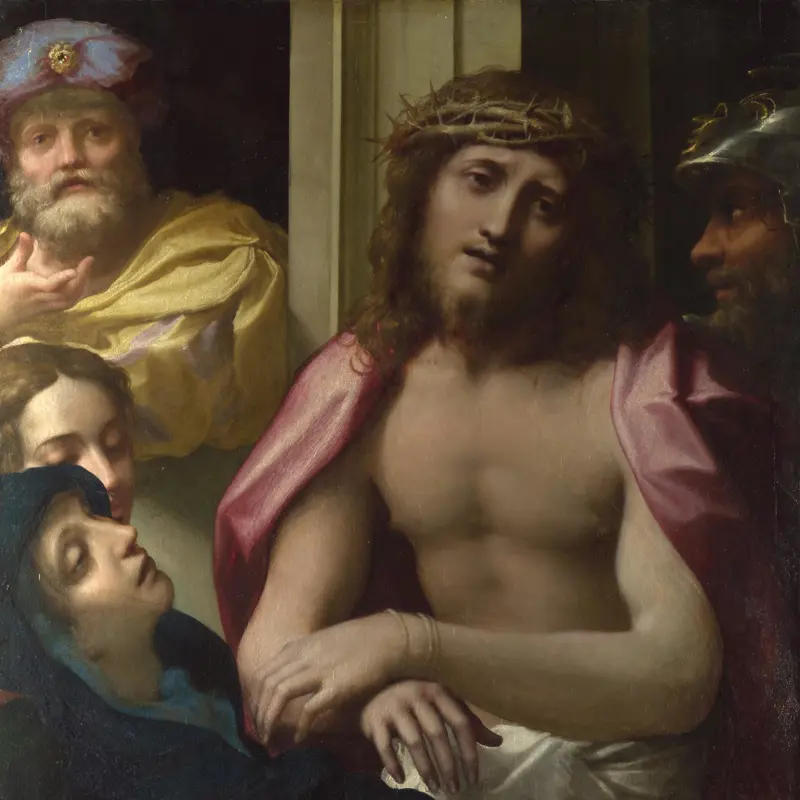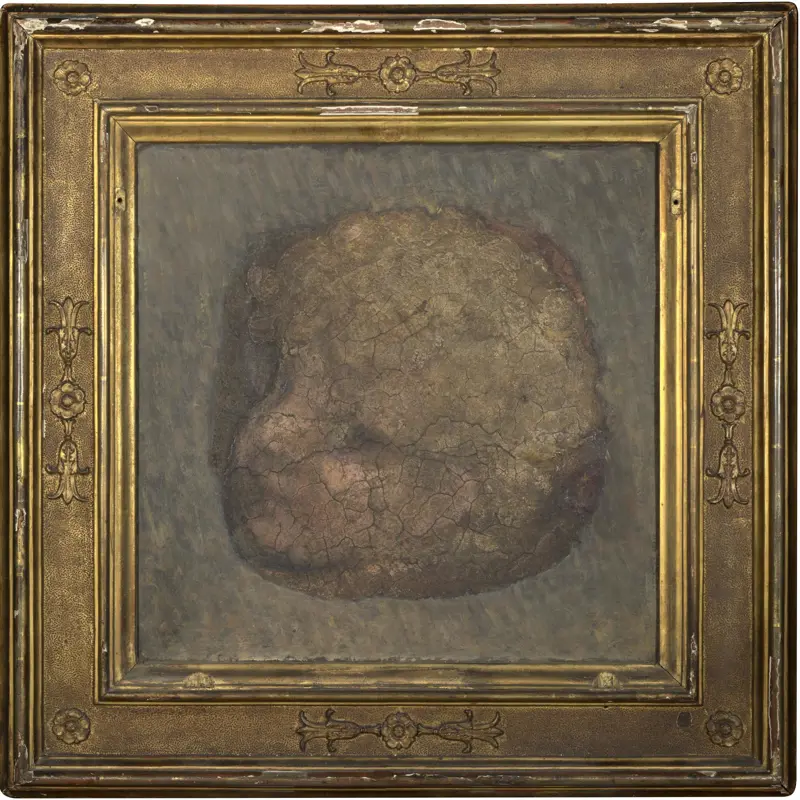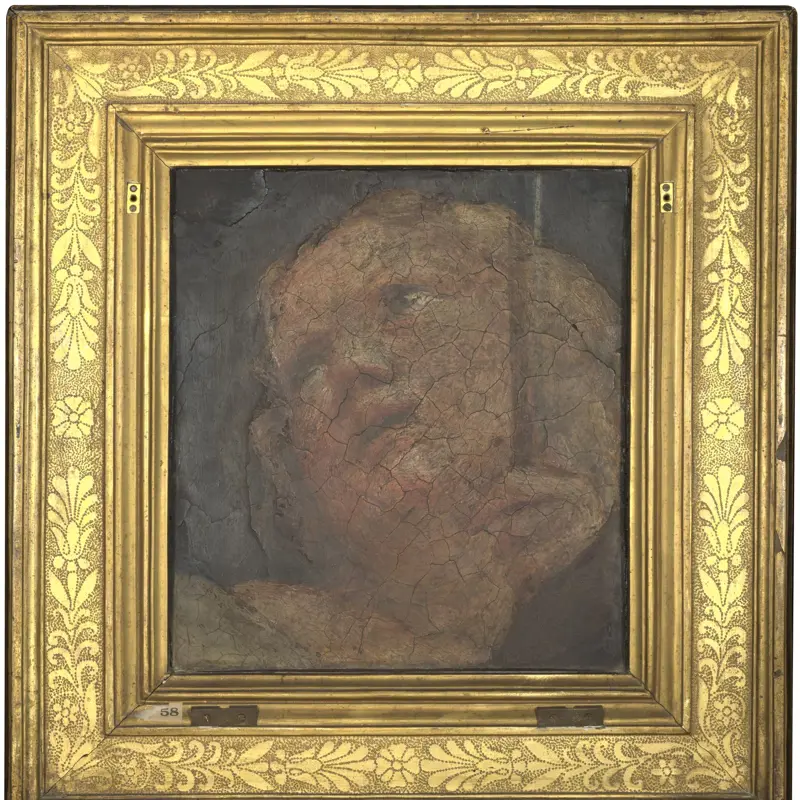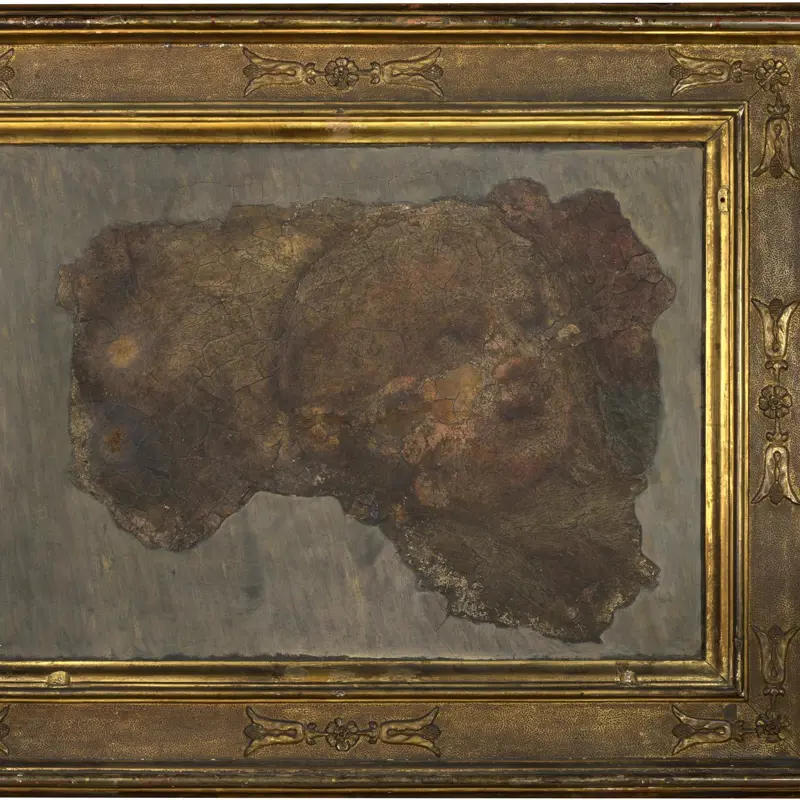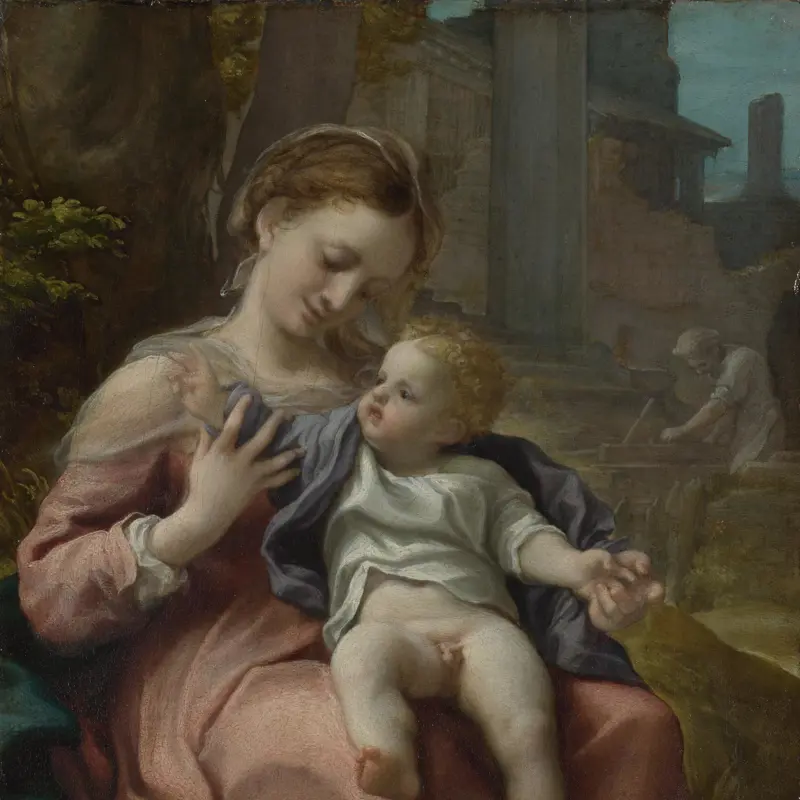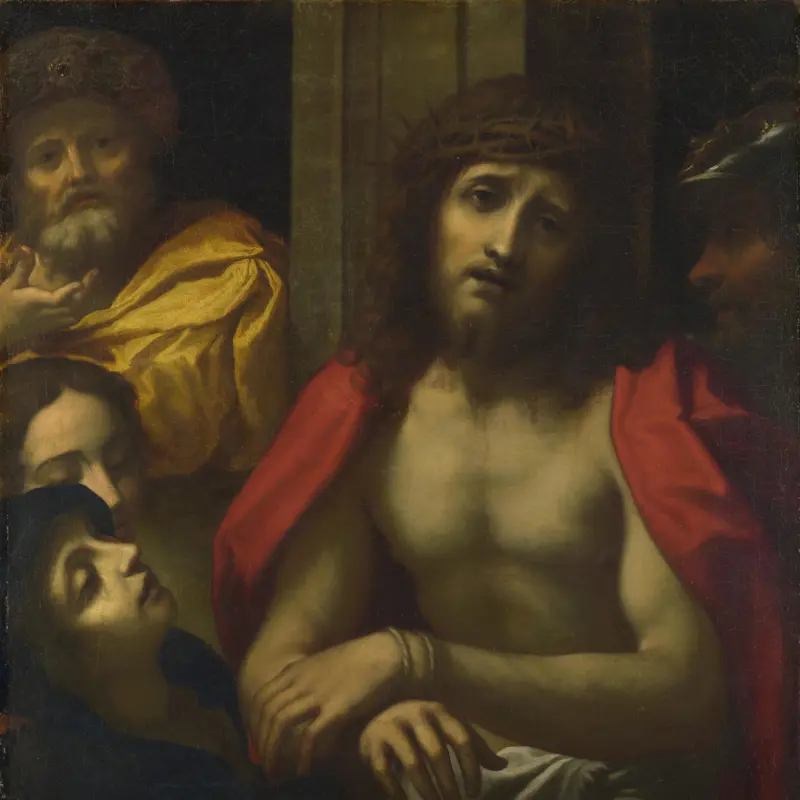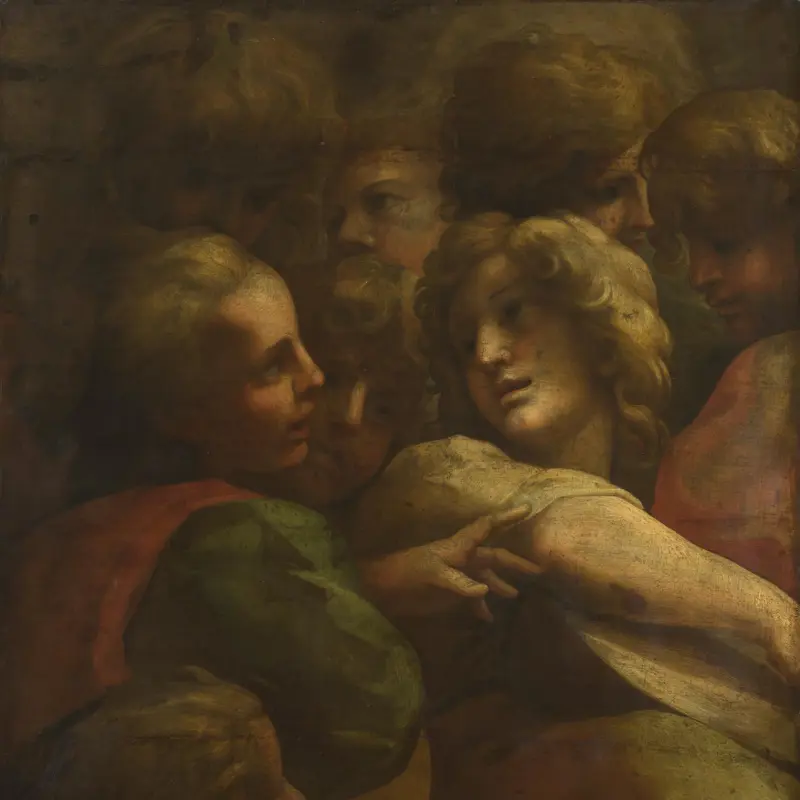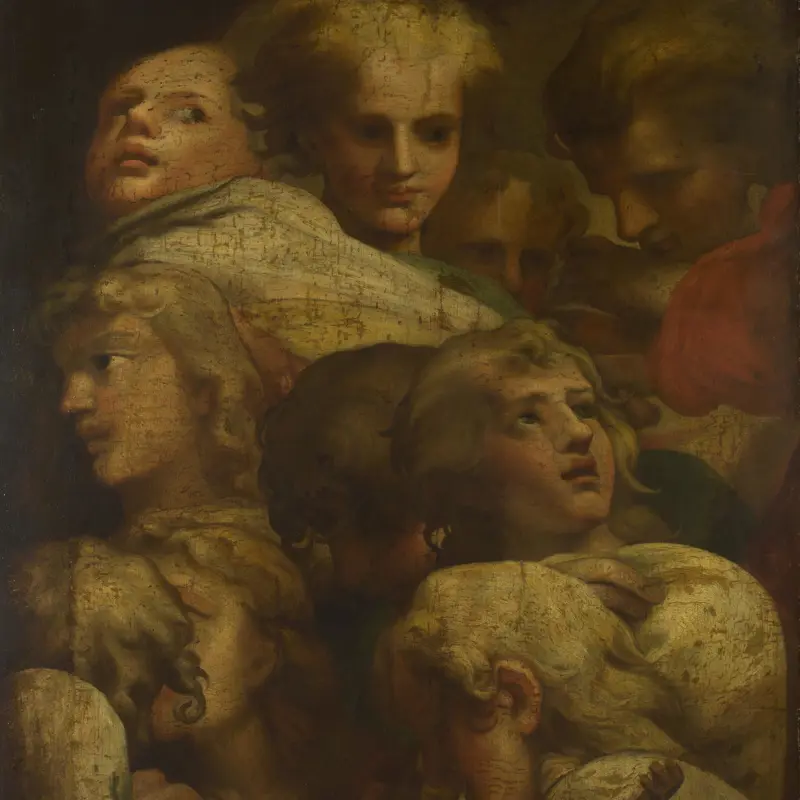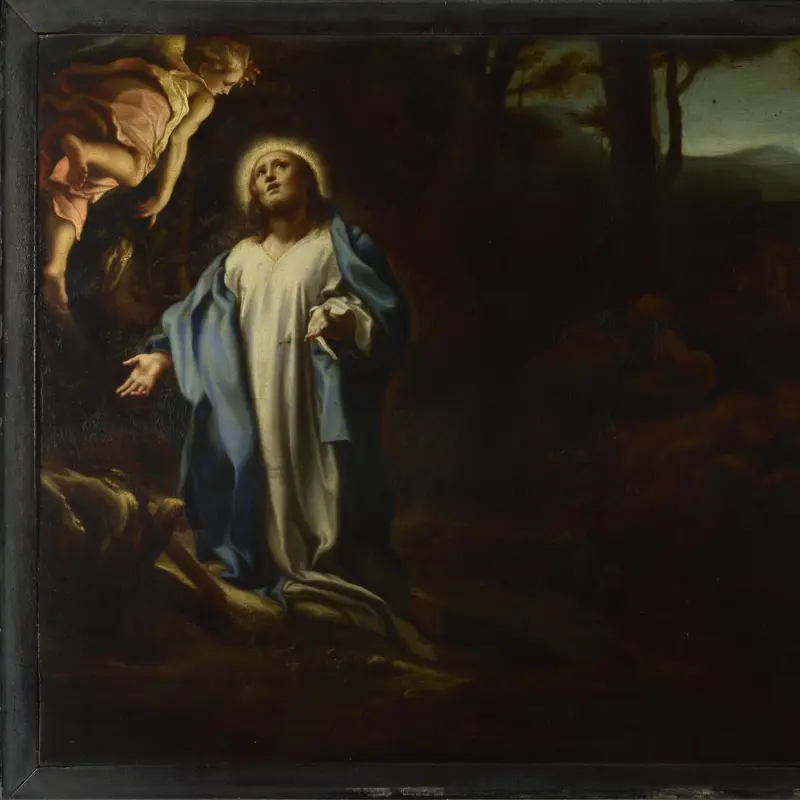Probably by Correggio, 'The Magdalen', perhaps about 1518-19
About the work
Overview
Mary Magdalene leans on a large book and holds the pot of ointment with which she anointed Christ’s feet. According to legend, she retreated into the wilderness of Provence and lived there alone, unreachable by man, and was brought bread by angels who sang to her. In penitence for her former life as a prostitute, she has abandoned all her jewels and finery and her hair is in disarray. She turns from her book to look at us, with one naked foot crossed over the other, and her breasts exposed.
Correggio’s depiction of a full-length Mary Magdalene in a landscape is very original. She is seamlessly integrated into her wild setting and the ivy, dandelions and plants are depicted in meticulous detail. A change made to the composition during painting has been considered as evidence that the picture is definitely an original by Correggio, but some regard it as a copy of a lost larger picture.
Key facts
Details
- Full title
- The Magdalen
- Artist
- Probably by Correggio
- Artist dates
- active 1494; died 1534
- Date made
- perhaps about 1518-19
- Medium and support
- oil on canvas
- Dimensions
- 38.1 × 30.5 cm
- Acquisition credit
- Salting Bequest, 1910
- Inventory number
- NG2512
- Location
- Not on display
- Collection
- Main Collection
- Previous owners
Provenance
A Magdalen attributed to Correggio and measuring about 1.027 × 0.77 m. is recorded in the collection of the Duke of Savoy at Turin in 1631 and Vertue describes a version 18" high by 15" broad in Charles I’s collection in which the Magdalen is ‘standing and leaning, being a little intire figure, which has been too much washed’. But it is doubtful whether either of these entries is relevant to no. 2512. Both sets of dimensions are too large and it seems that no. 2512 has not been cut down, since round the painted area there is an unprimed strip, about a quarter of an inch wide, of what appears to be the original canvas.
Apparently no. 25 in the Ravaisson-Mollien sale, Paris (Hôtel Drouot) 23rd November, 1903, bought by Christian de Marinitsch. Next recorded in England, in 1907, in the possession of George Salting (by whom lent to B.F.A.C. exhibition, 1907 (32)). Although on the strength of a reproduction in colour of lot no. 25 in the Ravaisson-Mollien sale catalogue there can be little or no doubt that no. 2512 is identical with that picture, its history during the intermediate period of four years is not satisfactorily accounted for. On the one hand it is stated by Herbert Cook that the picture came to England from Italy in 1907 and was then purchased by Salting. On the other, a picture of the Virgin and Child with two Angels (now National Gallery, no. 2608, (?) after ‘Campin’) which had also been bought by Christian de Marinitsch at the Ravaisson-Mollien sale had entered Salting’s collection by 1904.
Salting Bequest, 1910.
Additional information
Text extracted from the ‘Provenance’ section of the catalogue entry in Cecil Gould, ‘National Gallery Catalogues: The Sixteenth Century Italian Schools’, London 1987; for further information, see the full catalogue entry.
Exhibition history
-
2008Correggio in ParmaGalleria Nazionale (Parma)20 September 2008 - 25 January 2009
Bibliography
-
1907C. Phillips, 'Art Notes', Daily Telegraph, 1907
-
1910C. Phillips, 'The Salting Collection, II: The Italian Pictures', The Burlington Magazine, XVII/85, 1910, pp. 9-22
-
1930C. Ricci, Correggio, London 1930
-
1936B. Berenson, Pitture italiane del Rinascimento: Catalogo dei principali artisti e delle loro opere con un indice dei luoghi, Milan 1936
-
1953P. Bianconi, Tutta la pittura del Correggio, Milan 1953
-
1958R. Longhi, 'Le Fasi del Correggio Giovine e l'Esigenza del suo Viaggio Romano', Paragone, IX/101, 1958, pp. 34-53
-
1962Gould, Cecil, National Gallery Catalogues: The Sixteenth Century Italian Schools (excluding the Venetian), London 1962
-
1965M. Laskin, The Early Works of Correggio, Ann Arbor 1965
-
1975C. Gould, Delaroche and Gautier: Gautier's Views on the 'Execution of Lady Jane Grey' and on other Compositions by Delaroche, London 1975
-
1976C. Gould, The Paintings of Correggio, London 1976
-
1987Gould, Cecil, National Gallery Catalogues: The Sixteenth Century Italian Schools, London 1987
-
1993M. Di Giampaolo and A. Muzzi, Correggio: Catalogo completo dei dipinti, Florence 1993
-
1995M. Mussini, Correggio Tradotto: Fortuna di Antonio Allegri nella stampa di riproduzioni fra Cinquecento e Ottocento, Milan 1995
-
1997D. Ekserdjian, Correggio, London 1997
-
2001
C. Baker and T. Henry, The National Gallery: Complete Illustrated Catalogue, London 2001
-
2003M. Spagnolo, 'Correggio's Reclining Magdalen: Isabella D'este and the Cult of St. Mary Magdalen', Apollo, CLVII/496, 2003, pp. 37-45
-
2005M. Spagnolo, Correggio: Geografia e storia della Fortuna (1528-1657), Cinisello Balsamo 2005
-
2008L. Fornari Schianchi (ed.), Correggio (exh. cat., Galleria nazionale, Camera di San Paolo, Cattedrale, Chiesa di San Giovanni Evangelista, Parma), Milan 2008
-
2008L.F. Schianchi (ed.), Correggio (exh. cat. Galleria Nazionale, Camera di San Paolo, Cattedrale, Chiesa di San Giovanni Evangelista, 20 September 2008 - 25 January 2009), Milan 2008
About this record
If you know more about this work or have spotted an error, please contact us. Please note that exhibition histories are listed from 2009 onwards. Bibliographies may not be complete; more comprehensive information is available in the National Gallery Library.

